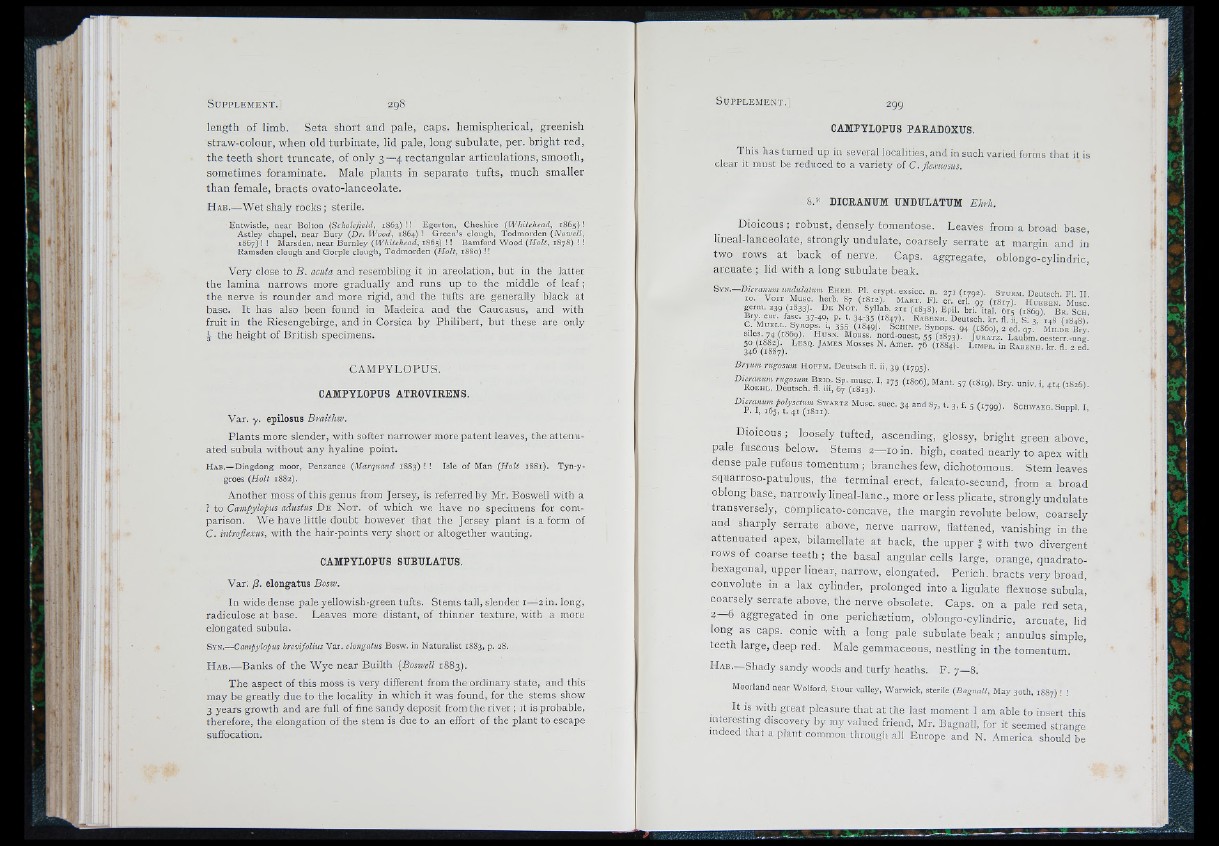
iï
length o f limb. S e ta short and pale, caps, hemispherical, greenish
straw-colour, when old turbinate, lid pa le, long subulate, per. bright red,
the teeth short truncate, o f only 3 —4 rec tangular a rticu lations, smooth,
sometimes foraminate. Male plants in separate tufts, much smaller
than female, b ra c ts o v ato-lanceola te .
H a e .— Wet shaly rocks ; sterile.
Entwistle, near Bolton [Seholefield, 1863)!! Egerton, Cheshire [Whitehead, 1865)!
Astley chapel, near Bury [Dr. Wood, 1864) ! Green’s clough, Todmorden [Nowell,
1867)! ! Marsden, near Burnley [Whitehead, 1865) ! ! Bamford Wood [Holt, 1878) ! !
Ramsden clough and Gorple clough, Todmorden [Holt, 1880) !!
Very close to B . acuta and resembling it in areolation, but in the latter
the lamina narrows more gradually and runs up to the middle of leaf ;
the nerve is rounder and more rigid, and the tufts are generally black at
base. It has also been found in Madeira and the Caucasus, and with
fruit in the Riesengebirge, and in Corsica by Philibert, but these are only
i the height of British specimens.
C A M P Y L O P U S .
CAMPYLOPUS ATROVIRENS.
Var. y. epilosus Braithw.
Plants more slender, with softer narrower more patent leaves, the attenuated
subula without any hyaline point.
H a b .— Dingdong moor, Penzance {Marquand 1883) ! ! Isle of Man {Holt 18 8 1 ). Tyn-y-
groes {Holt 1882).
Another moss of this genus from Jersey, is referred by Mr. Boswell with a
? to Cawpylopus adustus D e N ot. of which we have no specimens for comparison.
W e have little doubt however that the Jersey plant is a form of
C. introflexus, with the hair-points very short or altogether wanting.
CAMPYLOPUS SUBULATUS.
Var. /S. elongatus Bosw.
In wide dense pale yellowish-green tufts. Stems tall, slender i— ain. long,
radiculose at base. Leaves more distant, of thinner texture, with a more
elongated subula.
S y n .— Campylopus brevifolius Var. elongatus Bosw. in Naturalist 1883, p. 28.
H a e .— Banks of the Wy e near Builth {Boswell 1883).
The aspect of this moss is very different from the ordinary state, and this
may be greatly due to the locality in which it was found, for the stems show
3 years growth and are full of fine sandy deposit from the river ; tt is probable,
therefore, the elongation of the stem is due to an effort of the plant to escape
suffocation.
CAMPYLOPUS PARADOXUS.
This has turned up in several localities, and in such varied forms that it is
clear it must be reduced to a variety of C. fle.ntosus.
S.* DICRANUM UNDULATUM Ehrh.
Dio icous ; robust, densely tomentose. Lea ve s from a broad base,
lineal-lanceolate, strongly undulate, coarsely serrate at margin and in
two rows a t back o f nerve. Caps, aggrega te, oblongo-cylindric,
arcuate ; lid with a long subulate beak.
S Y N . - D f c r a , E h r h . Pl crypt, exsicc. n. 271 (1792). S t u r m . Deutsch. Fl. IL
to. V o it Musc. herb. 87 (1812). M a r t . Fl. cr. erl. 97 (1827). H u e b e n M usc
germ. 239 (1833). D e N o t . Syllab. 211 (2838), Epil. bri. ital. 613 (1869) B r S c h '
Bry eui. fasc. 37-40, p. t. 34-35 (2847). R a b e n h , Deutsch. kr. fl. ¡1, S. 3, 148 (2848).
i ■’ r iio p s . 94 (r85o), 2 ed. 97 M ime k y .
T N T T " ” ^-0002955(2873). J u r a 4 . LaubL. oesterr.-ung.
Mosses N. Amer. 76 ( 18 8 4 ). L im p r . in R a b e n h . kr fl 2 ed.
34b (1887).
Bryum rugosum H o f f m . Deutsch fl. ii, 39 ( 17 9 5 ) .
^ Ro“ S S h . ï S ; ®
U T U o T Y { T s Y W " *• 3- 5 ( V 99)- S c h w a e o . Suppl. I,
Dio icous ; loosely tufted, ascending, glossy, bright green above,
pale fuscous below. Stems 2— 10 in. high, coa ted nearly to apex with
dense pale rufous tomentum ; branches few, dichotomous. Stem leaves
squarroso-patulous, the terminal erect, falcato-secund, from a broad
oblong base, narrowly lineal-lanc., more or less p licate, strongly undulate
transversely, complica to-con ca ve, the margin revolute below, coarsely
and sharply serrate above, nerve narrow, flattened, vanishing in the
attenuated apex, bilamellate at back, the upper -| with two divergent
rows of coarse teeth ; the basal angular cells large, orange, quadrato-
hexagonal, upper linear, narrow, elongated. Perich. bra cts very broad,
convo lute m a lax cylinder, prolonged into a ligulate flexuose subula,
co a rse ly serrate above, the nerve obsolete. Caps, on a pale red seta,
2 5 a ggregated in one perichætium, oblongo-cylindric, arcuate, lid
lon g as caps, conic with a long pale subulate beak ; annulus simple,
teeth large, deep red. Male gemmaceous, nestling in the tomentum.
H ab.— Shady sandy woods and turfy heaths. F. 7—8.
Moorland near Wolford, Stour valley, Warwick, sterile (Bagnall, May 30th, 2887) ! !
It is with great pleasure that at the last moment I am able to insert this
mterestmg discovery by my valued friend, Mr. Bagnall, for it seemed strange
indeed that a plant common through all Europe and N. America should be